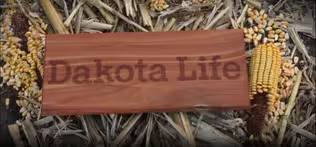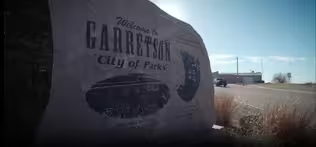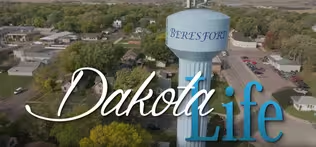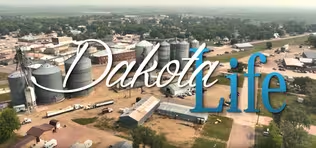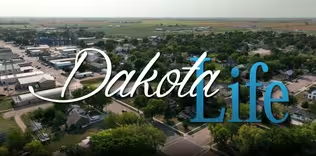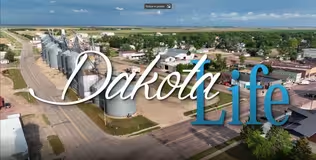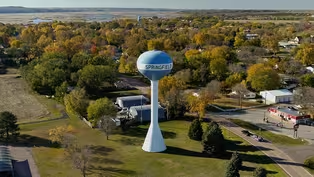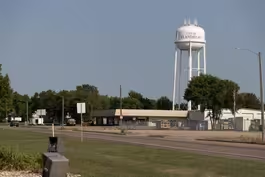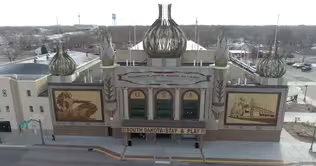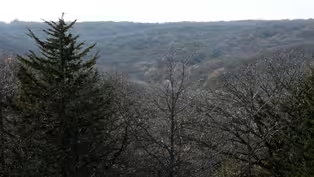Dakota Life
Greetings from Madison
Season 26 Episode 4 | 28m 55sVideo has Closed Captions
Greetings from Madison, the center of Lake County.
From the beginning, Madison has been a progressive community and a center for culture and the arts. While in Madison, we met a local artist, learned about the community's history with the Chautauqua, learned about the restoration of a steam-powered carousel, and met a group of aviation enthusiasts.
Problems playing video? | Closed Captioning Feedback
Problems playing video? | Closed Captioning Feedback
Dakota Life is a local public television program presented by SDPB
Support Dakota Life with a gift to the Friends of Public Broadcasting
Dakota Life
Greetings from Madison
Season 26 Episode 4 | 28m 55sVideo has Closed Captions
From the beginning, Madison has been a progressive community and a center for culture and the arts. While in Madison, we met a local artist, learned about the community's history with the Chautauqua, learned about the restoration of a steam-powered carousel, and met a group of aviation enthusiasts.
Problems playing video? | Closed Captioning Feedback
How to Watch Dakota Life
Dakota Life is available to stream on pbs.org and the free PBS App, available on iPhone, Apple TV, Android TV, Android smartphones, Amazon Fire TV, Amazon Fire Tablet, Roku, Samsung Smart TV, and Vizio.
Providing Support for PBS.org
Learn Moreabout PBS online sponsorshipMore from This Collection
Dakota Life stories from towns in southeast South Dakota
Greetings from Wessington Springs
Video has Closed Captions
Most cities shape the landscape they’re on, but in Wessington Springs it’s the other way around. (29m 45s)
Video has Closed Captions
Discover the beauty and history of Palisades State Park, goat yoga, and a very special love story. (29m 46s)
Video has Closed Captions
Beresford hosts the Frostbite 4, a regional favorite winter road race. (26m 26s)
Video has Closed Captions
From a window to the past to raising the next generation, Dakota Life explores Wagner. (28m 53s)
Greetings from the Corn Palace
Video has Closed Captions
Greetings from the Corn Palace plus stories from southeast South Dakota and Aberdeen. (26m 16s)
Video has Closed Captions
Dakota Life showcases Newton Hills and the SD State Park system. (28m 5s)
Providing Support for PBS.org
Learn Moreabout PBS online sponsorship- This is a production of South Dakota Public Broadcasting.
In 1870, William Lee and Charles Walker arrived in Dakota territory and shortly after established the town of Madison.
It was on the southwest side of Lake Madison.
Now both the lake and the town were named after Madison, Wisconsin.
That was where Lee and Walker's previous hometown was.
Well, three years later, Madison was named the county seat of Lake County.
But let's jump ahead to 1878.
Now this is when CD Kennedy came to Dakota territory and homesteaded in a spot between Lake Madison and Lake Herman.
A couple years later, 1880, the Chicago, Milwaukee and St. Paul Railroad was extended west from Flare.
It first arrived in Wentworth and then was built west to Kennedy's homestead.
Now, that was about five miles north of the original town of Madison.
And because of the railroad, Kennedy invited new residents of Madison to move to his homestead, and they did.
And that is why the New Madison is located where it is today.
So with the move, the first train arrived in the New Madison in January of 1881.
Now, since the beginning, Madison has always had a reputation of being a city of schools and churches.
CB Kennedy helped with that too.
He became the local representative to the territorial legislature and help secure Madison as the host for Dakota Normal School, the first teacher education school in the territory.
It was the beginning of what is now Dakota State University, a thriving university with a technical and community-based specialty.
And of course, with a nearby lakes, there's plenty to attract outdoor enthusiasts too.
And surrounding the entire area, our Scenic Lakes, hiking trails, two state parks and miles of Rolling Prairie.
Welcome to Dakota Life and Greetings from Madison - Dakota.
Life is made possible with your membership and the friends of SDPB.
Thank you.
With corporate support from Bankwest for over 130 years, Bankwest has built a reputation for helping customers and communities succeed with their roots firmly planted.
In South Dakota, Bankwest Associates provide financial services backed by hometown values and by Heartland Energy, providing wholesale electric energy and community development programs to municipal electric systems in the Midwest.
Heartland Energy, power with purpose.
Learn [email protected].
- The beauty of the rolling prairies in South Dakota are even more rich.
One seen from above in South Dakota, early aviators included the likes of Charles Lindbergh and Clyde Ice.
Lindbergh made several visits to South Dakota during his barnstorming years and the state recognized the potential of aviation and began investing in infrastructure.
On January 1st, 1965, the FAA activated the Madison Municipal Airport officially connecting Lake County to the world of aviation.
But there was a very interesting aeronautical challenge.
In 2011, local Dairy Queen, owner Delanor challenged then Governor Dennis Dugard to skydive if his Dairy Queen store sold more than 32,000 Blizzard treats during the Miracle Treat Day fundraiser.
Well, the store made the goal and the governor made the jump floating down safely to a landing here at the municipal airport.
The Madison Dairy Queen, by the way, is still a leader in fundraising on Miracle Treat Day.
And the interest in aviation is very strong here too.
Coming up the legacy of the Chatauqua in Madison, a unique carousel is up and running again at Prairie Village, a local artist whose excellent designs earned her a trip to Washington, but first will take flight with local aviators.
- For decades, the pilots of Madison have descended from the heavens above once a week to land at this runway adjacent hangar where they rest their wings and talk about their time in the sky.
For some it's a job.
For others, it's a hobby, but for everyone who shows up, it was love at first flight.
- The flying part is just relaxing this peaceful sailing over the countryside and looking at the corn fields, the bean fields, the farmers, seeing what they're doing.
Just checking it all out.
It's the Madison Aviation enthusiast.
- How long you been part of the club?
- Oh, 25 years.
Long time.
Well, we come out here on Thursday night and we cook out and people fly in and we just have a good time talking and telling stories.
- Yeah, we typically have people fly in from all over.
Like last week there was someone here from Idaho that comes every year on his way to Oshkosh.
There was someone here from Howard, there was someone here from Salem.
We usually get a lot of people that fly in and 'cause they know we get together on Thursdays.
There was a, a guy that owned this hanger, his name is Jay Van Layer, he built it and kind of decided to get outta airplanes and put it out for sale.
And I always told my wife that that's the nicest hanger at the airport or that's the one I'd like to own someday because you get to watch all the planes coming and going.
And my wife made a deal with Jay and got the hangar and people just stayed.
So they still meet here on Thursdays and, and even if I'm out of town, they, they still meet here.
They open it up and grill and close it back up again when they're done.
- While most here season pilots, Madison Airport is also where many aviation dreams take off.
- One day I went up for an introductory flight and when I was 16 here with Morris and I said I loved it, so I wanted to be a pilot and things didn't work out quite that way right away.
So I said, ah, I'll go to school to be a mechanic.
That sounds fun.
I loved it ever since.
So then I just became a pilot this year.
I'm from the area from Ramona, so it was nice to have a flight school close nearby and nice to have a bunch of guys that hang out on Thursday nights.
I'm from northeast Kansas.
I'm here to get my private pilot's license from Riggins Flight Service.
It's an accelerated program, so I'm in and out in four weeks.
I'll have everything done.
Whereas like most guys, you know, it takes you like six months to a year to get done with just your private, - A lot of times 30 students at the flight school.
So a lot of them will, will come here and most of them are getting their commercial license.
Some are being ag pilots, some will wanna be, you know, airline transport pilots, whatever they they want to do.
- I've kind of been getting some inklings about doing crop dusting, but I'm not a hundred percent sure if that's a that's the route I want to take yet or not.
So we'll see what happens.
- As far as the people locally that get together here are mostly just for fun.
Hobbies.
- I didn't know anybody when I showed up, but like now I know people's names and I'm, I'm getting to know guys and talking to these old timers, it's awesome.
You know, they have a lot of stories and good history behind them and it, it's solid guys and they're, they're not afraid to talk.
And people here just really friendly.
The the biggest thing I like to say is get around it as much as you possibly can.
When I was younger and senior in high school, I already knew I wanted to be in aviation.
I knew since I was 16, but I started trying to get myself involved in this stuff.
I did job shadows for aviation maintenance.
I went up to colleges, I made sure this is what I want to do first.
And then I started going to college and then I started loving it.
I mean it, the way I see it is it's just do what you love and you'll never work a day in your life.
- Absolutely.
If you got any interest at all, learn how to fly.
I always thought that I probably couldn't do it, but I'm living proof that you can.
I thought maybe I had to be really smart.
But no, you don't just need somebody to show you how to do it.
And then practice.
You can learn right here at the Madison Airport.
- The original Madison was established in 1875.
The nearby town of Herman was established.
Three years later, the two towns became bitter rivals to be the administrative center for Lake County.
Now, when settler CB Kennedy established the new Madison, residents of the original Madison were eager to make the transition.
Herman, not so much.
Eventually the residents there agreed to move to the new town site along the rail line, but not right away.
The nearby lakes though are still named Madison and Herman, but the town of Herman, like so many prairie towns of the 18 hundreds, no longer there.
From the very beginning, Madison has been progressive and a center for culture and the arts.
In 1891, the Madison people built the Lake Madison Chatauqua on the northwest shore of Lake Madison.
At first, the Chatauqua visitors came by horse and buggy or by narrow gauge steam railway.
But later on, the Milwaukee line from Sioux Falls to Madison actually built a spur in to spur into Chautauqua.
Thousands of visitors from around the four state area came to be entertained by the Chautauqua performers of national and even international renowned.
- In the early years of statehood, Chatauqua was the place to be.
- There were hundreds of people, thousands of people sometimes that that attended events at the Chautauqua ground, it was huge.
They had, they had people like former President Taft came and talked Booker t Washington.
There were preachers and musicians and teachers of all sorts that came and presented workshops and they had concerts.
And it was a, it was an opportunity to see things that you couldn't see if you were a, a local person in, you know, 1900 - People would come from Sioux Falls, Minneapolis, Sioux City, Iowa, and they'd catch the train to Madison.
And then there was an extra spur railroad that was created to take people directly out to the Chautauqua grounds.
- Chautauqua was a traveling education and entertainment event, the connected citizens across the nation to a shared lineup of popular entertainers and authors and politicians and thought leaders.
- So Miss Minna, may Lewis, June 28th to July 10th, children's entertainer, reader and lecturers exceptionally well qualified to meet the demands of the Chautauqua audiences, which are everywhere, becoming more critical and demanding higher class attractions.
Walden magician and Illusionists, the engagement of Mr. Walden, the great magician on the chatauqua program for July 5th, sixth, and seventh promises a change from the regular routine.
He proposes to rest our emotional senses and rouse the faculty of forthcoming the mysterious.
He also promises to please the fascinate, the eye with beautiful creations and magic.
I think it helped bring the country together after the Civil War.
The ideas we, we, it made, it made.
South Dakota pulled us into the national thought process.
I think we were experiencing what other communities were experiencing and understood.
- The Lake County Museum where brew works houses one of the largest collections of Chautauqua artifacts.
And it's where volunteer Denise Lewis has donated hundreds of hours researching and cataloging the Lake Madison Chautauqua collection of programs, flyers, meal coupons and photographs.
- Chautauqua exposed the community, every community that it existed in.
It exposed people to things that wouldn't get to see otherwise because if you put yourself back in that era, there was no internet.
There was no ability to get educated online.
There was no ability to watch a concert online.
- While most hosts, communities put up temporary circus-like tents for Chautauqua, the Chautauqua grounds at Lake Madison were home to permanent Chautauqua structures.
A 2,500 seat auditorium, grand hotel and swimming pavilion.
Chautauqua attendees took full advantage of all Lake Madison had to offer.
- There was lots of recreation people would like.
They same thing they do today at the lake.
They fish, they boat, they get out on the water, they swim.
They had slides and swim platforms built.
They had a boathouse built.
There was canoes and row boats to rent.
There were leisure cruise boats that would steam powered boats that would take you out on a scenic cruise of the lake.
- So where is Chautauqua?
- Denise Lewis became interested in Chautauqua because she grew up on Lake Madison and her childhood home sits across the lake from where the Chautauqua grounds once stood.
And even though the last Chautauqua was held in 1931 and the event's permanent structures were long ago, replaced by modern homes, Lewis feels strongly about the lasting impact Chautauqua had on the community of Madison.
- It's a significant part of our local history and people may or may not realize that it spurred our growth and Madison has prospered ever since, really, that it was a historic movement in the, in the country.
And this happened to be the location of one of one of the most successful in the Midwest.
- Looking at a map, it's not hard to see how Lake County got its name, it's the home to beautiful lakes and many other prairie potholes and s sloughs all formed by melting glacier ice thousands of years ago.
Lake Herman has been a popular campsite for hundreds of years before white settlers entered the picture.
It was home to Native Americans traveling eastward to the nearby Pipestone quarries.
The first European settlers at Lake Herman were Herman Luce and his son William.
They settled on the Timberland on the east side of the lake.
Today, lake Herman State Park is on a peninsula with a spectacular view of the lake as well as camping, boating, and fishing in the summer and cross country skiing in the winter.
The log cabin in the park was built by Herman Luce in the summer of 1871.
The cabin was made of sturdy oak logs, hand hued to fit snugly and shanked to keep out the winter cold Lu's cabin briefly served as a US land office with loose in charge.
In 1977, the Herman Le Cabin was placed on the National Register of Historic Places.
Now let's go to the other side of the lake.
There you'll find 120 acre Prairie Village.
It features more than 40 antique filled buildings and active turn of the century, main street and a unique ride that draws visitors from around the world.
- Well, the Carousel came here, the, the Year Prairie Village was founded in 1966.
The gentleman who owned it at the time, and he had purchased it secondhand as a, as an old carousel kind of a project.
His name was Art Thomas, and he was the patriarch of the Thomas shows carnivals that used to be based in Lennox, South Dakota.
And by 1966, when Prairie Village was, was getting ready to open the first steam threshing show here, he recognized that it might be a good fit and he was looking to possibly sell it and he wanted it to stay in South Dakota.
So he brought it, set it up here, and the folks that were forming Prairie a Village had the opportunity to see it during that first steam show here.
And they fell in love with it as he hoped they would.
And he had one more show, he had to take it to the state fair that fall under agreement and said, I will take it to the fair and be back, and if you still want it, we will make a deal.
He came back in October and set it up and the founders said, yes, we, we would like that.
And they purchased it and it's been here ever since.
Attempt sort of structure was first erected and that protected the, the carousel structure as well as gave the riders some, some respite from the sun and, and the elements.
And then over time that structure evolved into a, a full wood roof and eventually later to the structure we house it in.
Now over the years, it became more and more necessary to make plans for some kind of a large restoration because most of the, the working components were still wood, original wood from circa in 1900.
It was recognized that there was going to need to be a, a full restoration.
And the the cost of course was the, the major stumbling block.
At one point, funds were available to bring a representative from Carousel Works, which is an organization in Ohio that did restoration of wood carousels like this.
And it was costly just to bring a rep here to take a look and make a, an estimate.
Once those funds were available, one of those representatives came here and, and bid the project.
And unfortunately at that point the bid was such that it appeared still too out of reach.
Just about the time I started in 2016 as general manager, it was decided that a second bid should be looked at.
And so the organization that had come earlier offered a second estimate and sure enough the price had gone up significantly and, and it was clear that that was only going to continue to sky.
Yeah, at that point our, our board of directors said, we better do this now or, or forever consider it it outta reach.
And by that fall, carousel works came from Ohio, they disassembled the carousel and took it away and we started madly raising funds and a year and a half later it came back and by the time we had our homecoming celebration, it was paid off.
We understand that it was built sometime between 1895 and 1905.
Okay, that's as close as the firm that restored it could even date it.
So we'll, we'll take that.
No one knows better than they do.
So first of all, it's of course a very, a very vintage carousel.
But to have a carousel of that age still operating in, in its basically original form in a manner that the public can still come and ride.
And then add to that, the fact that we have the steam engine that we believe is the original steam engine that would've come with this carousel and that steam engine is still state certified.
And a couple of times during the year we disconnect the electricity and we power this unit by steam, original steam.
We don't know of any others in the country that have that entire conglomeration of opportunity all wrapped into one.
Many of the young people who ride as young as two or three years old are so overjoyed while they're riding as they come off and, and just want to keep doing it again and again.
But at the same time, we have folks of every age including very senior senior citizens who, especially once they recognize the history and understand that the special nature of what they're riding, they're completely enthralled and it's an experience they didn't know they were going to receive and every age in between.
So the, the experience, especially once you understand the history is very rich and, and people leave richer for it.
- Madison has grown to a population of over 6,000 and there's a very supportive arts community here too.
In 1964, the Community College Arts Association was incorporated and it eventually evolved into the Madison Area Arts Council.
30 years later in 2009, they established the Brick House Community Arts Center to better serve the community.
And today the Brick House also serves as an organizational office and archives.
They hold monthly public meetings and it provides a gallery and studio space for educational programming.
The Madison Master Singers are a mixed choir and they entertain throughout the area with winter and spring concerts.
In the summertime, you can hear the all volunteer community band and Madison recently started a community theater.
It's known as Mad Arts Theater.
It's built as a free range theater company.
There's an improved and updated movie theater in town too, and the local library is adapting to changing demographics by offering bilingual activities for over 30 years, local artist Allison Nagle has been mastering her art, becoming well-known for her eccentric statues and novelty, salt and pepper shakers.
- For Allison Nagle art has always been her passion.
- When I was a teenager, I enjoyed drawing, sketching, and painting.
My folks always provided me an area that I could do paintings and bought me the supplies and it just went from there.
- While oil paints were the starting point, a chance encounter would allow Allison an opportunity to unlock her true potential.
- In 1978, I was living in northern Minnesota and an artist that lived in the town where I was, was designing and making porcelain art dolls for Neiman Marcus.
And she saw one of my oil paintings and out of the blue called me and asked me if I would be interested in learning the art of porcelain and working for her.
And I had no clue what it was.
And I said, why not?
And she brought an artist in and we had a three day crash course and I went and bought my equipment and never looked back - With a change in medium came.
New challenges.
- Well, oil paints are completely different than the paints for porcelain.
Porcelain is probably a finer and denser clay than say like dolomite or something in a, just a regular coffee mug or a figurine.
Stoneware would be comparable, but it's a lot grittier and coarser.
So porcelain is, I always say, is kind of the fine clay and it, it fires up to almost a glass light consistency.
So it's very strong.
- An artist's inspiration comes from many forms.
For Allison Hearst comes from the most important meal of the day.
- When I was working for the doll artist, I was in a supply store buying my porcelain and and brushes and so forth.
And here on the shelf were three little bisque.
That means they were already fired, ready to paint bisque eggs and I, they were a dollar each.
So I purchased them, took them home, and I painted three little portraits on these eggs and I just fell in love with the shape and the idea that I could do my own thing.
And I went from there.
I bought some commercial molds, I made my own eggs and started painting on them.
- That involved into Allison's excellent art, becoming staples of Bob culture.
- I love the old Sci-Fi and Oscar winning like Lawrence of a gra.
And we've got Jurassic Park and you name it, you've got a movie that you can make the eggs be the characters.
- Allison's creative skills would eventually lead her from her home in Madison to a much more famous home.
1300 miles away.
- I was doing Brookings art in the park and the president of the South Dakota Egg Board was strolling through and saw my display full of eggs.
And he gave me his card and he said, I'm looking for an artist who will do the South Dakota egg for the White House at Easter.
And I said, sure, I'd be happy to.
And he says, but you have to do 'em on a real egg.
The first one I did was of Humpty Dumpty wearing a wall drug T-shirt.
Every year I was invited, but the last year I did it, I decided to go and I took my daughter and it was a wonderful experience for both of us.
We got to meet Laura Bush, have our picture taken, and have a brunch with her and a tour of the White House - After all these years.
Allison isn't slowing down anytime soon.
- I'm just so grateful.
I'm grateful for a wonderful full life.
I'm not finished, but I'm just grateful for those 40 plus years that I've been able to do what I love doing.
So I thank the universe for that for sure.
- In most communities that we visit, we mention the Native American or white ethnic heritage of the area.
But here in Madison, there's another European connection, a group of Swiss settled north of here in the late 18 hundreds.
They founded the town of Bados, but all that's left there is a church and cemetery descendants of those Swiss immigrants are still around.
And I know that because there was a young man in the second wave of Swiss immigrants.
His name was a Lewis Carroll Rohrer.
However, my grandfather changed his name to Lewis Carl when he arrived in America.
He and his brother now rest together in a cemetery just south of Elkton in Brookings County.
Madison keeps looking forward.
Like Dakota State University, founded in 1881 as a teacher training school education is still a heritage mission, but a focus on technology was added in 1984.
DSU offers programs on computer management, information systems, and other computer related undergraduate and graduate programs.
So in a sense, Madison is a back to the future from the Living Legacies at Prairie Village to the technology management skills taught at Dakota State.
And it's all wrapped up in a friendly hometown feel from the lakes to the business districts here downtown.
We hope you've enjoyed your visit to Madison.
You can see even more stories about this area on our website and you can replay or share our stories about Madison and Lake County and all of the other communities we visit at sdpb.org/dakota Life.
Thank you for watching and from Lake County.
I'm Larry Rohr for all of us at SDPB.
Thanks for coming along for the ride.
Support for PBS provided by:
Dakota Life is a local public television program presented by SDPB
Support Dakota Life with a gift to the Friends of Public Broadcasting
